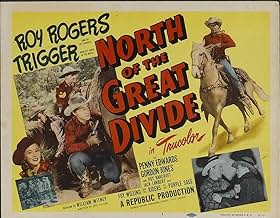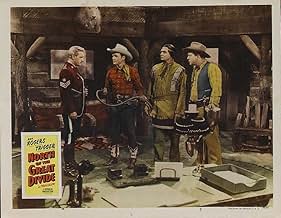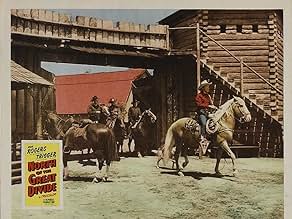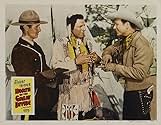अपनी भाषा में प्लॉट जोड़ेंThe annual return of the salmon each year gives the Indians of the Northwest enough food to last until the next year. This way of live is threatened by Banning who puts in a cannery on the r... सभी पढ़ेंThe annual return of the salmon each year gives the Indians of the Northwest enough food to last until the next year. This way of live is threatened by Banning who puts in a cannery on the river to harvest the fish for sale. With the Canadian cannery on the other side, the Indian... सभी पढ़ेंThe annual return of the salmon each year gives the Indians of the Northwest enough food to last until the next year. This way of live is threatened by Banning who puts in a cannery on the river to harvest the fish for sale. With the Canadian cannery on the other side, the Indians find no fish in the river for them. But Banning wants all the fish for his business and ... सभी पढ़ें
- Proprietor
- (बिना क्रेडिट के)
- Henry Gates
- (बिना क्रेडिट के)
- Buttermilk
- (बिना क्रेडिट के)
- Canadian Mountie
- (बिना क्रेडिट के)
- Sheriff Bradley
- (बिना क्रेडिट के)
- Headdress Presenter
- (बिना क्रेडिट के)
फ़ीचर्ड समीक्षाएं
One of the notable aspects of the Roy Rogers movies is their tolerance, and willingness to spend a few minutes in the films explaining aspects of different cultures. Whether he's down further south dealing Mexicans or up in the Northwest dealing with indigenous culture, there's respect for other viewpoints, even if the on-screen representations skew towards stereotype rather than sociological accuracy. This one shows the Indians' dependence on the salmon, and their reverence for the chance to pursue their lives. What could be more American than that?
There are also some good songs, a couple of good stunt sequences, and second-billed Trigger, as well as Bullet the dog. Certainly, it's not a masterpiece that notably advances the art of film making, but under the direction of William Witney, and with long-time cameraman Jack Marta's practiced compositions, the willing audience gets what they hope for in an hour's entertainment. For an example of commercial art, that's good value.
A pleasant time pass with Roy Rogers and Trigger coming to the rescue by helping his Indian friends who are in state of starvation due to the actions of the b-western heavies Roy Barcroft and Jack Lambert. The pace is nifty, the scenery is splendid, though it's lacking in the action department- however, there's a brutish whipping scene at the finale - but it's social and serious theme that makes this TRucolor western shine.
This later Roy Rogers film is similar to many others of the period....it's really NOT a western and features Rogers as a do-gooder and not a cowboy despite his clothing. Generally, I dislike these film, as they tend to be a bit too nice and lack an edge....and "North of the Great Divide" is no exception.
The story begins with Roy hanging out with his Native American friends. He apparently is an Indian agent for the US government. But things go from great to lousy very quickly when a new salmon cannery is built along the river. Now there isn't enough food for the locals and the newcomers have no problem depleting all the fish...all in the name of money. But these greedy folks now have decided to destroy the other cannery on the Canadian side of the border. In the process, they end up killing a Mountie...and soon the local tribesmen are blamed. Can Roy straighten all this out and stop these mad men?
Apart from seeing Roy fight a whip fight, there isn't a ton about this one to love. Gordon Jones is less a sidekick, and more an idiot. All in all, a disappointing film in most ways...and a film that relies too often on grainy stock footage.
The film is set in the Pacific Northwest near the Canadian border and deals with a tribe of Oseka Indians that suffers a loss of their food supply when Banning, a corrupt cannery owner on the U.S. side (played by Roy Barcroft), puts up traps that keep the salmon from reaching the Indian fishing waters. Rogers plays an Indian agent assigned to solve the problem and works closely with Chief Nagura (Noble Johnson) and his son, Tacona (Keith Richards). Rogers gets caught up in an international incident when a Canadian Mountie is killed and the Canadian cannery sabotaged and Nagura is charged with the crimes. Under pressure to turn Nagura over to the Mounties, Rogers goes up against Banning when he tries to get evidence of his duplicity.
It's not clear when the film is set. Everybody rides horses and carries six-shooters. The Mounties are stationed in an old log cabin fort from the frontier era. In a typically Hollywood bit of cross-cultural confusion, the Pacific Northwest Indians look and live like Plains Indians, complete with buckskin, feather headdresses and tepees, with totem poles planted incongruously about. The film mixes a good deal of Trucolor location photography (employing real Indians) with extensive studio work and bits of stock footage of cannery operations and salmon swimming upstream. The three different modes of filming don't always blend well.
Two great western heavies, Roy Barcroft as Banning and Jack Lambert as his whip-wielding henchman, Skagg, make suitably nasty villains. Penny Edwards, looking quite fetching in buckskin, is the leading lady (giving Dale Evans a break) and plays a field nurse assigned to help Roy. Unfortunately, fan fave Penny is given little to do here. The lack of a strong female presence throws the Rogers formula slightly off balance.
Famed Indian actor Iron Eyes Cody is on hand to give his blessings to the proceedings but has no real role. Top acting honors go to Noble Johnson as Nagura, seen here in his final film credit after a 35-year film career. Johnson, a black American actor (and one-time schoolmate of Lon Chaney Sr.) appeared in hundreds of Hollywood films in all kinds of ethnic roles-Egyptian, Russian, Mexican, Polynesian, South Asian, Chinese and, most frequently, American Indian. He is probably best known as the native chief on Skull Island in KING KONG (1933). Interestingly, the role of Nagura may have been the biggest speaking part in Johnson's entire career.
The Trucolor photography is not seen to best advantage in the tape available for review, the initial VHS release from NTA, the corporate predecessor of Republic Pictures Home Video. Republic has since released a new edition, which hopefully improves on the earlier release and looks as good as some of Republic's other Trucolor Roy Rogers VHS releases (e.g. THE GOLDEN STALLION, TRIGGER, JR.). Overall, this is a worthy later Rogers entry, better than some, but not as good as THE GOLDEN STALLION (1949), Rogers' near-masterpiece. It deserves note for its serious intent and social issue theme but is not as rousing or packed with humor and action as a more typical Rogers vehicle of the time.
क्या आपको पता है
- ट्रिवियाFinal film of Rose Higgins.
- कनेक्शनFeatured in The Roth Show: The New York City Way (2014)
- साउंडट्रैकNorth of the Great Divide
Written by Jack Elliott
Performed by Roy Rogers and the Riders of the Purple Sage
टॉप पसंद
विवरण
- रिलीज़ की तारीख़
- कंट्री ऑफ़ ओरिजिन
- भाषा
- इस रूप में भी जाना जाता है
- Intiaaniverta
- फ़िल्माने की जगहें
- उत्पादन कंपनी
- IMDbPro पर और कंपनी क्रेडिट देखें
- चलने की अवधि1 घंटा 7 मिनट
- पक्ष अनुपात
- 1.37 : 1
इस पेज में योगदान दें






























